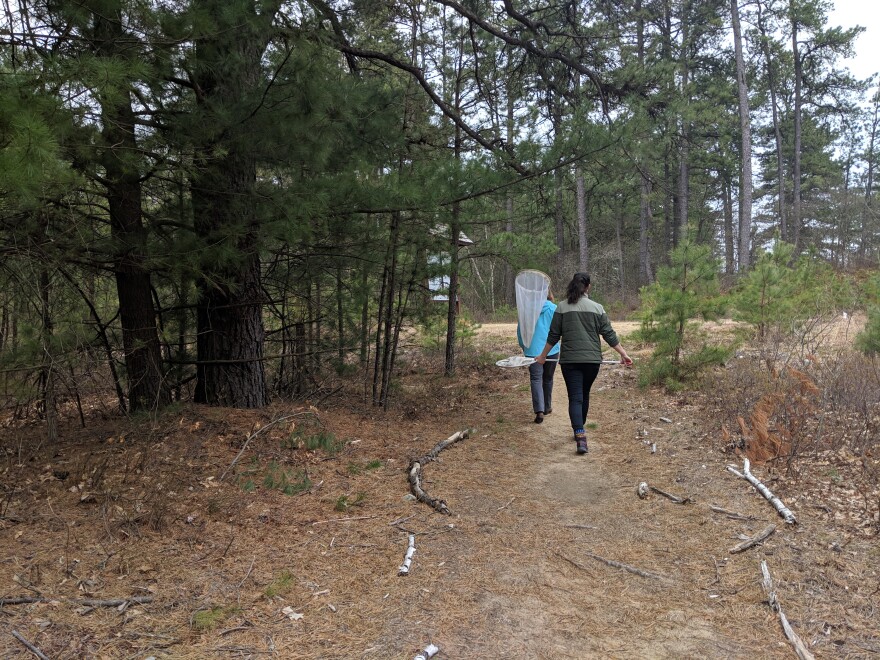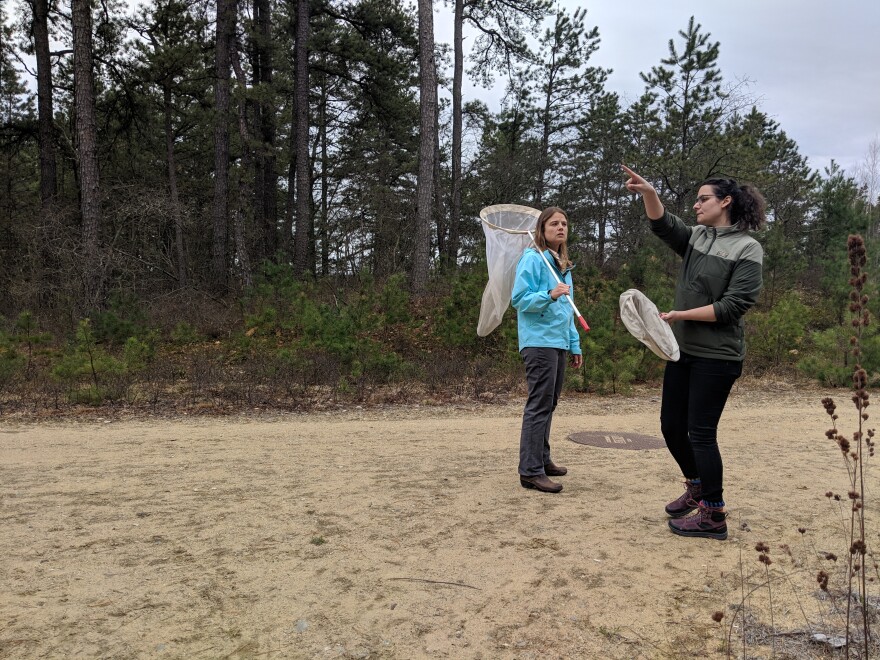It's been about two decades since the government project began to preserve New Hampshire's state butterfly, the Karner blue. Since then, the Karners have rebounded in their specially-conserved pine barrens near the Concord Municipal Airport.
Now, scientists are turning their attention to another butterfly in the same area. The research is shedding light on the wider effects that this kind of habitat preservation can have.
The frosted elfin butterfly doesn't look nearly as fancy as its name suggests. It's small, no bigger than a quarter, with mousy brown wings and little black spots.

New Hampshire Fish and Game biologist Heidi Holman unzips one of several small mesh cubes inside the makeshift greenhouse at the state's butterfly breeding lab.
"There are 500 chrysalises in all of these tents," she says.
Holman reaches into a tent with some butterflies that have recently emerged, and delicately lifts out a frosted elfin.
"Up close to it, you'll see that it has this little dusting kind of like an icing of the bottom wing," she says. "That’s the frosting that gives it its name."
Holman and her team raised these butterflies as caterpillars last year.
Biologist Samantha Derrenbacher is in charge of the menu: She comes in every day to feed lupine leaves to hundreds of caterpillars, and mix a nectar of honey and minerals for the butterflies.
"You've gotta prepare their meals daily," Derrenbacher says, laughing.
These butterflies are getting the star treatment because, scientists say, they’re a living example of how protecting one species can ripple out to help many others.

This is the basis of a study for the U.S. Fish and Wildlife Service about how to help frosted elfins thrive in the wild. Because elsewhere, across nearly all of these butterflies' range between Texas and the Northeast, scientists aren't sure how the species is doing.
Fish and Wildlife is considering listing the butterfly as endangered. But first, they need to know more about how to study and protect it.
This is where New Hampshire comes in. Thanks in large part to conservation work for the Karner blue butterfly, the state's population of frosted elfins is now thriving and ripe for study.
"Our contribution to the effort is to … get all of the ins and outs figured out, find out where some of its vulnerabilities are, and maybe do some research in the field," Holman says.

It turns out the frosted elfin population has nearly tripled in the pine barrens that were restored to save the Karner blues over the last 20 years.
Holman says it created an ideal case study – a way to write a blueprint for scientists in other states on how to conserve the elfins, especially where they may be at risk.
We make the short drive from the butterfly breeding lab to the pine barrens, where research is picking up on the frosted elfins.
Holman and her team have been able to capture hundreds for study in this unlikely setting, behind an industrial park, municipal airport and military base.
"The pine barrens – it doesn't look like your backyard," she says, walking down a sandy trail between thickets of bushes and evergreens. "It has these really scraggly pine trees with thick bark – that's the pitch pine tree – and it has these thick shrubby oaks called scrub oaks, and a lot of blueberry and sweet fern in the understory."
This is a place for specialists – rare species that subsist off a rare habitat. Holman and her team sweep along the shrubbery with big nets, trying to stir up a frosted elfin or even a Karner blue.

"The females will hang out in the lupine plant to lay eggs, so you can hustle 'em a little bit with the net," Holman says.
But on the day we visited, in mid-spring, it was too cold and wet for many butterflies to be out, and the lupines weren't yet in bloom.
Another benefit of studying frosted elfins here is to see the effects of climate change on the ecosystem, where periodic wildfires are supposed to keep the sandy soil fertile.
Fire helped scientists restore this habitat – but their latest burn was two years ago.
Holman says there's been too much rain ever since. They've been cutting the plants back by hand instead, and it seems to be working so far. But there's plenty more study to do.
It won't just help scientists understand the frosted elfin. It'll shed light on this whole unique ecosystem and how it's changing. It's like a chain reaction of conservation, all stemming from the Karner blue project.
"We chose one particular species to serve as the model … and protected some space, and numerous species benefited," Holman says.
Safeguarding biodiversity and habitat, she says, is always about more than just one creature.









